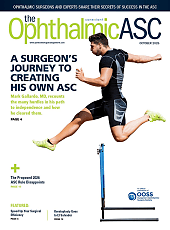The dry eye treatment landscape has been active over the last few years. Today, we are doing more than just “scratching the surface” of dry eye disease (DED) and its unwelcome partner, ocular surface disease (OSD). Several estimates have the prevalence of DED in the United States at more than 20 million, while the global estimate hovers closer to 350 million individuals.1,2
When Restasis (cyclosporine ophthalmic emulsion) became the first FDA-approved prescription drug for chronic DED in April 2003, its manufacturer, Allergan (now AbbVie), made clear that it addressed the role of inflammation and the need for more tear production. The impact of Restasis in the market was significant for many stakeholders, including the myriad of patients and providers within ophthalmology and optometry.
Then, in 2022, with Restasis’ loss of exclusivity and several generic cyclosporine entrants introduced to the market, it seemed that the glory years of dry eye treatment were over. Shire’s Xiidra helped grow the market, but as this asset was sold to larger healthcare companies, it appeared the dry eye market was no longer a top priority. More recently, however, numerous companies have come to the market with dry eye assets that address inflammation and tear production, offer alternative mechanisms of action, or address a subset of dry eye. (See “Identifying the Best OSD Treatment for Your Patient.”)
Understanding OSD’s Multifactorial Nature
Ocular surface disease represents a spectrum of conditions characterized by tear film instability, inflammation, and disruption of the ocular surface homeostasis. This complexity requires a nuanced approach to diagnosis and treatment, which may be why it represents one of eye care’s most prevalent yet challenging therapeutic areas. As Eric Donnenfeld, MD, said recently, “For years, we’ve recognized dry eye as an inflammatory condition, but we now understand that OSD encompasses far more than just aqueous tear deficiency.” 3
The diversity of delivery mechanisms—from traditional eye drops to nasal spray and oil-based formulations to lacrimal occlusion—allows clinicians to tailor therapy to patient needs and tolerance. Some of these medications and interventions also target disease subsets that may overlap with DED, such as meibomian gland dysfunction (MGD) or Demodex blepharitis.
Bausch + Lomb’s Miebo offers a novel mechanism of action for treating evaporative eye disease, with studies showing significant improvement in tear film breakup time and meibomian gland functionality.4 The role of Demodex mites in OSD has gained significant attention. Tarsus Pharmaceutical’s Xdemvy has demonstrated efficacy against Demodex blepharitis, addressing an often-overlooked contributor to ocular surface and lid inflammation.5

Emerging Treatments
The future of OSD treatment looks promising with several candidates in development. Some of these target novel inflammatory pathways while others take a neurosensory approach. While this list is not exhaustive, below are some of the “coming attractions.”
Reactive Aldehyde Species Inhibition
AbbVie’s preliminary partnership with Aldeyra is developing reproxalap, a RASP (reactive aldehyde species) inhibitor that targets a novel inflammatory pathway implicated in DED.6 Phase 3 clinical trials have shown promising results in symptom reduction.
Targeting Keratin Dysfunction
Azura’s development program focuses on a compound that provides a multimodal approach. The company’s lead keratolytic compound uses selenium sulfide, addressing both symptoms and underlying pathology by softening keratin blockages within meibomian glands and reducing abnormal keratin production to prophylactically address future obstructions.7
New Delivery Systems
Meanwhile, Alcon is expanding its OSD portfolio with a candidate in late-stage development, a novel delivery system designed to improve patient compliance and therapeutic outcomes.8 This includes its transient receptor potential melastatin 8 (TRPM8) agonist, AR-15512, which leverages trigeminal nerve activity to stimulate lacrimal and meibomian gland tear production, thereby addressing a core component of ocular surface disease.8
The illumination of the interaction between the various layers of the tear film—lipid, aqueous, mucin—as well as MGD and demodex has expanded the dry eye landscape immensely. Thus, the best way to direct treatment and serve patients is by ensuring the appropriate subtype is identified first.
Conclusion
The evolving landscape of OSD treatment offers unprecedented opportunities for tailored therapeutic and interventional approaches. By understanding the multifactorial nature of this condition and leveraging the expanding arsenal of treatments, clinicians can significantly improve outcomes for the millions of patients suffering from this chronic and at times debilitating condition.
As our understanding of OSD pathophysiology continues to evolve, so too will our treatment strategies. The future promises even more targeted therapies, improved delivery systems, and enhanced diagnostic capabilities—all working synergistically to address this complex condition. OM
References
1. Craig JP, Nichols KK, Akpek EK, et al. TFOS DEWS II Definition and Classification Report. Ocul Surf. 2017;15(3):276-283. doi:10.1016/j.jtos.2017.05.008
2. Farrand KF, Fridman M, Stillman IÖ, Schaumberg DA. Prevalence of Diagnosed Dry Eye Disease in the United States Among Adults Aged 18 Years and Older. Am J Ophthalmol. 2017;182:90-98. doi:10.1016/j.ajo.2017.06.033
3. Corry M, Donnenfeld ED, Calkins DJ. Dry Eye Breakthroughs in the Making. CRST. January 2025. https://crstoday.com/articles/jan-2025/dry-eye-breakthroughs-in-the-making
4. Sheppard JD, Evans DG, Protzko EE. A review of the first anti-evaporative prescription treatment for dry eye disease: perfluorohexyloctane ophthalmic solution. Am J Manag Care. 2023;29(14 Suppl):S251-S259. doi:10.37765/ajmc.2023.89464. https://pmc.ncbi.nlm.nih.gov/articles/PMC11311291/
5. Aldeyra Therapeutics, Inc. Aldeyra therapeutics achieves primary endpoint in phase 3 dry eye disease clinical trial of Reproxalap. News release. Aldeyra Therapeutics, Inc. August 8, 2024. Available at: https://www.businesswire.com/news/home/20240808408806/en/Aldeyra-Therapeutics-Achieves-Primary-Endpoint-in-Phase-3-Dry-Eye-Disease-Clinical-Trial-of-Reproxalap. Accessed April 7, 2025.
6. Sheppard JD, Nichols KK. Dry Eye Disease Associated with Meibomian Gland Dysfunction: Focus on Tear Film Characteristics and the Therapeutic Landscape. Ophthalmol Ther. 2023 Jun;12(3):1397-1418. doi: 10.1007/s40123-023-00669-1. Epub 2023 Mar 1. PMID: 36856980; PMCID: PMC10164226.
7. Wirta DL, Senchyna M, Lewis AE, et al. A randomized, vehicle-controlled, Phase 2b study of two concentrations of the TRPM8 receptor agonist AR-15512 in the treatment of dry eye disease (COMET-1). Ocul Surf. 2022;26:166-173. doi:10.1016/j.jtos.2022.08.003
8. Alcon. Alcon Announces Positive Topline Results From Phase 3 COMET Trials of AR-15512, a Novel Topical Drug Candidate for Dry Eye. News release. Alcon Inc. January 9, 2024. Available at: https://www.alcon.com/media-release/alcon-announces-positive-topline-results-phase-3-comet-trials-ar-15512-novel-topical/. Accessed April 10, 2025.










